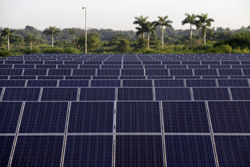
Economy runs on Energy
Reliable supply, bring more sustainable development
PROFILE

Production

Storage
The industry does not possess sufficient liquids handling and storage facilities to coupled with refined products, LPG and off
load vessels; in some ports these facilities are not available. A particular emphasis has been placed on increasing the storage
of fuel capacities to improve distribution and logistic operations.
Oil and gas production is equivalent to 3 million tons of crude oil per year, and approximately 1,100 million cubic meters of natural gas per year. Not to mention 20 prospect blocks in the Cuba's EEZ with an extraction potential of 10,000-20,000 barrels
Cuba's energy sector disposes of three oil producing companies and four refineries located in Havana, Cienfuegos, and Santiago de Cuba. The primary focus is the production of high-quality asphalt with domestic crude and gasoline to meet country’s demand.

Refinery

In Dec 2020, Cuba's Crude Oil: Imports were reported at 64.837 Barrel/Day
Records decreased from the previous yearly numbers
Moving from Oil and Gas exploration and production to Renewable Energy power generation
OVERVIEW
Cuba is in need of energy to support his ambitious economy growth and domestic demand; the energy industry requires not just supply but considerable investments to reach higher levels of generation and distribution. The Industry generates 95% of its electric power by burning crude oil. It becomes a challenge to guarantee stability on the national grid as a result of oil import dependency parallel to power plants running on either imported or unrefined domestic petroleum which in turn limits operating plans capacity to a fraction of their whole potential.
The portfolio of investment opportunities indicates that exploration activities continue with the aim to substitute crude imports. Dozens of fields have been discovered recently offshore, which are accessible by horizontal land drilling, allowing to reach not only the grounds but also more significant productivity.
DIVERSIFICATION
Cuba's strategy focus on the use of clean technology integrated with
energy storage
Insufficient electricity production has created a need for energy infrastructure diversification, the exploitation of solar, wind and other renewable resources in the areas in which they are best suited, this can produce more even distribution of resources and boost the economy
 |  |  |
|---|---|---|
 |
The limited supply of fuel oil constitute an uneven distribution among the economic sectors, a vast majority of Cuba’s domestic oil production goes into power generation. Diversifying energy portfolio in electricity production is part of a strategic plan in the electric power system. Cuba is blessed with extensive and exceptional renewable energy resources (wind, solar, Bio-energy, geothermal, hydro) sufficient for engaging in producing clean energy, tackling environmental challenges and fossil fuels dependency.
3 799 functioning wind farms
The majority of Cuba’s existing renewable energy installed capacity comes from bio-energy, driven mainly by the sugarcane industry
Average solar irradiance
of 223.8 W/m2 (5.4 kWh/m2/day)

Despite efforts on the search for new oilfields and improvement of recovery in those long under exploitation; the industry disclosed the construction of 600,000 barrels of fuel oil storage in the port of Matanzas to revitalize fuel oil supply. Essential agreements for projects in the ZEDM; such as facilities for the storage and supply of gas; including a new fuel terminal have been in the scope among these priorities. Cuba has a unique geographic location not only to become a learner engagement point for oil and gas distribution across the region, providing maritime transport services to US, Mexico, and Latin America but also possesses the potential to be a robust regional trade partner in the area of energy and infrastructure development.
A few joint-venture projects currently ongoing in energy development and infrastructure (oil refineries, pipelines, and
port facilities) between Cuba and a fast expanding list of
foreign partners is an optimistic indication of that potential.

INVESTMENT
The energy sector is one of the 12 areas prioritized for foreign investment; must of the oil production come from the region between Havana and Matanzas where oilfields still contain reserves of some six billion barrels. Promotion to attract investors has listed options to joint production contracts in the development of fields in the country's EEZ in the Gulf of Mexico, coastal waters, and inland fields. The industry has little choices but to turn to international partner or finance investors to improve oil production, as well as to work on non-conventional sources.
In term of exports; emphasis focus on identifying market opportunities in commercializing technologies that include equipment for oil drilling, refining, renewable energy projects, power, and electricity industry.

BUSINESS: Investments in energy infrastructure creates the basis to expand production, storage, and refining capacity

REGULATIONS: Government regulations are open to private energy investment and trade in energy technology and services.

CONTRACT: Investors considering participation in the oil and gas industry will obtain contracts approved and protected by a government resolution.

TAXATION (Law 113): A unique regime of 50% bonus during payback period has been establishing for exploitation of natural resources.

Transmission and distribution challenges in a growing energy demand
CONTACT
Inquiries

Partner
We are more than interested in hearing from integrated companies and specialized supplies with whom we can work together to transform the energy system towards a well sustainable industry. We pay considerable attention to the challenges and make extra efforts to identify associated risks involved in potential opportunities.
Network
To read the latest information and share market value; we encourage you to follow our social network links